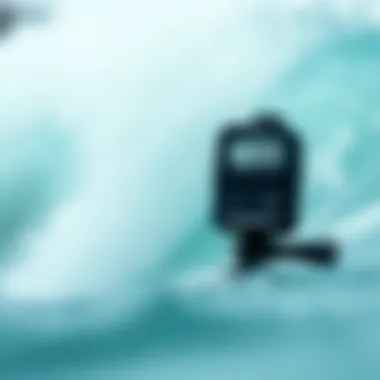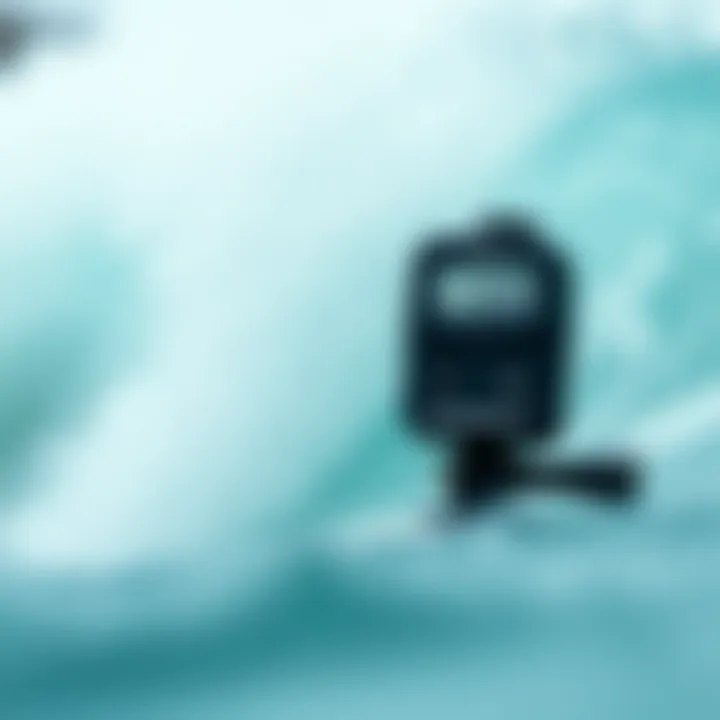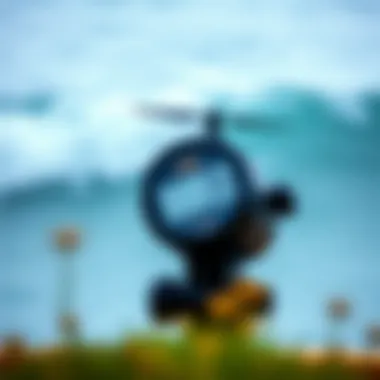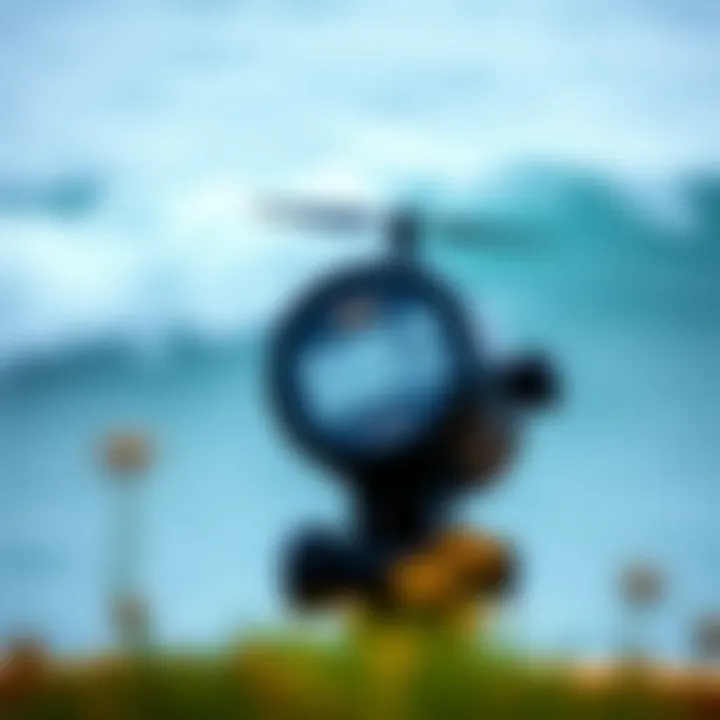Understanding Anemometer Units for Surfing


Intro
When it comes to catching the perfect wave, understanding the wind is just as essential as knowing your surfboard. The relationship between wind speed, direction, and wave quality can turn an average day at the beach into an exhilarating adventure. This article aims to crack open the nuts and bolts of anemometers and their units, diving deep into how these factors influence surfing conditions.
Anemometers are instruments that help measure wind speed and, in some cases, direction. For surfers, having a grasp of these measurements can make the difference between a day of fabulous rides and facing the frustration of flat waters. From beginners yearning to find their footing to seasoned surfers looking to leverage advanced techniques, the relevance of accurate wind readings cannot be overstated. We will elaborate on various measurement units, including knots and the Beaufort scale, fostering a solid foundation for every surfer's understanding.
By breaking down these units and their implications, this article aims to elevate the surfing experience. Whether looking at how wind shape affects wave height or considering the best wind direction for smooth rides, every surfer—traveler, coach, or fitness professional—will benefit from a clearer comprehension of what the data really means. Let's surf into the world of winds and waves.
Prelims to Anemometers
Anemometers are essential tools in the field of meteorology and outdoor sports, particularly surfing. Understanding these devices can lead to safer and more enjoyable experiences on the water. They measure wind speed and direction, data that surfers rely on to choose the best conditions for catching waves. Knowing how anemometers work enables surfers to gauge the surf conditions accurately, which is crucial for ensuring a good ride and enhancing safety.
Definition and Purpose
An anemometer is a device that measures wind speed and, in some cases, wind direction. It's a vital instrument in various fields including aviation, meteorology, and surfing. The main function of an anemometer is to transform the kinetic energy of the wind into measurable data. There are different types of anemometers, such as cup, vane, and hot-wire, each suited to varying situational needs.
For surfers, the primary purpose of this device is to provide reliable information about wind conditions. The readings can help to inform decisions—whether to hit the water or stay on land. Wind affects wave height and structure; thus an accurate understanding of wind speed is not just helpful but necessary for a great surfing experience.
Role in Surfing
The role of anemometers in surfing extends far beyond mere measurement. They provide essential data that surfers utilize to navigate their activities strategically. Here are some of the beneficial aspects of using anemometers:
- Safety: By understanding wind conditions, surfers can avoid hazardous situations such as strong winds that may lead to dangerous waves or currents.
- Skill Development: Knowing how to read wind data can help surfers pinpoint optimal surfing conditions. This understanding can dramatically enhance one's skills and techniques.
- Planning: With a reliable anemometer, surfers can plan their surf sessions more effectively, taking into account not just current conditions but also predicting future ones based on wind patterns.
Units of Measurement
Understanding units of measurement in the context of wind dynamics is paramount for surfers aiming to harness the elements to their advantage. The way in which wind speed is quantified can significantly impact a surfer’s experience on the water. Different units convey not only velocity but also the feel of the conditions, how waves will break, and how stable the ride will be. Ultimately, grasping these measurements can enhance not just performance, but overall enjoyment.
Overview of Units
In the world of sailing and surfing, various systems exist to express wind speed—each with its peculiarities. Meters per second, kilometers per hour, miles per hour, and knots are the most commonly used units. Each has its own advantages and is favored for different practical applications.
- Meters per second (m/s) is often used in scientific contexts and provides precise speed measurements.
- Kilometers per hour (km/h) is common in many regions, particularly in Europe.
- Miles per hour (mph) is prevalent in the U.S., especially among outdoor enthusiasts.
- Knots, primarily used in maritime and aviation settings, is another critical unit.
It's particularly useful to note how different surfing locations may favor different measurement units, potentially influencing the choice of tools or applications used by surfers to prepare for their sessions.
Standard Units
Standard units of wind measurement provide a reliable way to assess conditions before hitting the waves. Each unit has its own context where it shines, ensuring that surfers can make informed decisions based on the environment.
- Meters Per Second: This metric unit is straightforward and easy to calculate. When a wind speed reading comes in at, say, 5 m/s, surfers can quickly ascertain the wind's energy—a crucial factor when selecting waves.
- Kilometers Per Hour: Rounding up speeds to ensure clarity, especially in surfing reports, makes this unit popular across Europe. For example, 20 km/h translates roughly to 5.56 m/s, often used in local swell reports, ensuring surfers are well-prepared.
- Miles Per Hour: In regions like the U.S., speed readings in mph are common. This unit resonates well with local surfers, making discussions about wind lively and relatable. If a surf report mentions a wind of 10 mph, it directly correlates to how surfers might visualize conditions before paddling out.
- Knots: Used extensively in both aviation and maritime settings, knots might sound foreign but carry significant info relating to wind speed. One knot equals approximately 1.15 mph, making it essential for those engaging in both surfing and other water sports to understand this unit.
Understanding these standard units maximizes a surfer’s ability to interpret wind data effectively. Whether you’re riding swells in California or plotting wind patterns along the coast of France, knowing your unit of measurement is the key to riding the waves successfully.
"Knowing the wind speeds in your surfing area can mean the difference between a thrilling session and an average one."
All in all, whatever measurement unit one chooses to trust, it's essential that surfers familiarize themselves to enhance their experience in the vast sea.
Common Anemometer Units
Understanding common anemometer units is critical for surfers aiming to catch the perfect wave. Each unit of measurement offers insights into wind conditions that can greatly influence both performance and safety. Knowing how these units translate into actual surfing experiences can equip surfers with the ability to make informed decisions. Without grasping these details, one might find themselves missing out on ideal conditions or, worse, surfing in hazardous winds.
Meters Per Second


Meters per second (m/s) is a standard metric measurement used globally. This unit is often favored for its straightforward nature. For those surfing, a wind speed of 5 m/s suggests a gentle breeze – plenty enough to shape good surfing conditions without overpowering beginners.
When you check a report and see wind speeds exceeding 10 m/s, it’s time to proceed with caution; those conditions might kick up some serious chop on the water, making riding waves challenging. Moreover, many anemometers will display wind data in m/s by default, so it's a bedding of knowledge to understand this measurement.
Kilometers Per Hour
Kilometers per hour (km/h) is another familiar unit, particularly for surfers in regions like Europe and Australia. It's often used in weather reports, making it essential for those who look at forecasts to prepare for a day at the beach. To put things in perspective:
- 0 - 15 km/h: Generally good conditions for most surfers.
- 15 - 25 km/h: More experienced surfers are likely to enjoy this, but beginners might find it difficult.
- 25 km/h and above: Conditions could be rough; only the most skilled surfers should hit the waves.
So, when you’re deciphering a report, knowing how to convert km/h to m/s can help maintain your confidence in the water.
Miles Per Hour
In some places, especially the United States, miles per hour (mph) is the preferred metric. While this unit isn't as commonly used in surfing, it still plays a significant role, especially for those who track wind data via American platforms. Like km/h, wind speeds in mph can indicate varying levels of surf conditions:
- 1 - 10 mph: Ideal for beginners, who can practice without overwhelming winds.
- 10 - 20 mph: Intermediate surfers may find these conditions entertaining, giving good wave performance.
- 20 mph and above: Can lead to challenging aquatic situations; navigate carefully.
Therefore, being able to interpret mph readings can help you align your skill level with the wind conditions at play.
Knots
Knots are another crucial unit, particularly in maritime contexts. One knot equals about 1.15 mph, which can often confuse surfers who aren't used to this measurement. Typically used by sailors and windsurfers, knowing wind conditions in knots can give surfers insight into how conditions translate to the water. A common scale to understand it better:
- 0-10 knots: Calm conditions perfect for those just starting out.
- 10-20 knots: For surfers with some experience, these winds can create fun and fast waves.
- Above 20 knots: Proceed with caution; this can translate to very choppy waters, best left to the pros.
Understanding knots helps those who may venture out on both boats and surfboards alike, providing a solid grasp of wind conditions when taking to the waves.
Specialized Measuring Systems
When it comes to surfing, simply having an anemometer isn’t enough. You need to be aware of the specialized measuring systems that inform you about wind conditions and influence your surfing experience. These systems not only offer clarity on wind speeds but also provide context in a way that conventional units alone often can’t.
A significant advantage of using specialized measuring systems like the Beaufort Scale is that they translate complex wind data into understandable terms. For surfers, who may not be meteorologists, a simplified scale that correlates wind speed with observable effects can make a world of difference in decision-making. With easy-to-interpret categories, surfers can quickly gauge how the wind might affect the waves. The next time you're at the beach, consider how the wind feels against your skin or the surface of the water before you head out.
Specialized systems also encourage better safety measures. By educating surfers on how wind affects conditions, these tools serve as a guideline for safety precautions. For example, if conditions fall under a particular Beaufort grade signaling rough seas, a surfer might think twice about heading out.
Moreover, advancements in technology have given birth to various types of anemometers that utilize different methods of measurement. This allows for more versatile data collection in real-time and contributes to more reliable wind forecasts. Choosing the right type of anemometer ultimately comes down to the specific use case, whether you're a casual surfer checking conditions or a professional looking to optimize performance.
In summary, specialized measuring systems play a pivotal role in how surfers interact with the ocean environment. They simplify complex data and underscore the importance of understanding wind conditions in a practical surf application.
Beaufort Scale
The Beaufort Scale stands out among specialized measuring systems as it transforms wind speed readings into everyday language. Developed in the early 19th century, this system categorizes wind speeds into force levels, ranging from 0 (calm) to 12 (hurricane force). Each level features a description of expected effects on land and sea, which can be immensely useful for surfers who need to gauge conditions quickly without getting bogged down in numbers.
Key Features of the Beaufort Scale:
- Intuitive Descriptions: Each force level is accompanied by observations like "light breeze" or "gale," making it easier for surfers to comprehend.
- Practical Applications: By looking at the scale, a surfer can determine if a session will be pleasant or perilous just by glancing at wind speed classifications.
- Visual Representation: Many surf forecasting websites incorporate Beaufort ratings into their reports, providing a visual tool for easy understanding.
In practice, a surfer in the water might find that a force 3 (gentle breeze) buoyantly lifts waves, making for a fun ride. Meanwhile, a force 6 (strong breeze) could leave even seasoned surfers feeling overpowered.
Anemometer Types
The realm of anemometers is vast and varied, with each type geared towards specific needs of wind measurement. This diversity is crucial for surfers, who rely on accurate and relevant data about wind conditions. Understanding the different types can help choose the right tool for obtaining the best conditions for riding waves.


- Cup Anemometers: These are perhaps the most recognized type, featuring three or four cups that spin in the wind. They provide reliable average readings and are widely used in both personal and professional contexts.
- Vane Anemometers: Equipped with a rotating blade and a display, vane anemometers offer both wind speed and direction, making them highly valuable for surfers needing directional clarity.
- Digital Anemometers: These modern devices come with digital readouts and can record data over time. They often feature advanced functions like memory storage and averaging features, useful for surfers wanting to track conditions consistently.
- Hot-Wire Anemometers: These sophisticated instruments measure wind speed by detecting changes in thermal properties, offering precise readings suited for technical applications. While not common for surfing per se, they serve important roles in research and professional forecasting.
Using the right anemometer type can significantly impact your understanding and interaction with wind conditions while surfing.
In choosing the correct kind of anemometer, consider your surfing style, level, and the environments in which you typically surf. Different instruments can yield different results, and finding the one that fits your needs can enhance your overall surfing experience.
Selecting the Right Anemometer
When it comes to surfing, selecting the right anemometer can make all the difference. You want to ensure you have reliable data to inform your decisions. Choosing the wrong device may lead to poor surfing conditions, which can be frustrating and even dangerous. The right anemometer helps you stay informed, improving not just your chances of catching good waves, but also enhancing your overall experience in the surf.
Factors to Consider
Several factors play a crucial role in determining the right anemometer for your needs. Understanding these can ultimately save you from an untimely disappointment at sea. Here are some key points to think about:
- Accuracy: You want your anemometer to provide precise measurements of wind speed and direction. A negligible deviation can lead you to misjudge conditions, which could dramatically alter your surf experience.
- Durability: This is especially vital for surfers since the ocean isn't gentle with equipment. Look for anemometers designed to withstand marine environments, often resistant to water, sand, and salt.
- Portability: If you're always on the move, a compact and lightweight anemometer can be a lifesaver. Many options nowadays are easy to carry, making them suitable for travel.
- Battery Life: Regularly replacing batteries can be a pain. Opt for devices with extended battery life to keep you in the water longer without interruption.
- Display Readability: Conditions can be variable; thus, having a clear and easily readable display is essential, especially during intense sunlight where glare can be an issue.
"Wind can be fickle, but the right tools make a world of difference in how you ride it."
Adaptability for Surfing
Not all anemometers are created equal; some cater to specific activities better than others. When it comes to surfing, adaptability is key. Here’s what you should think about:
- Measurement Units: Choose an anemometer that allows you to toggle between different units of measurement, like meters per second, kilometers per hour, or knots. Surfers operating in various regions might encounter different unit preferences.
- Multi-functionality: Some anemometers come with additional features, such as temperature, humidity metrics, or even a built-in GPS. These can provide a complete picture of the conditions, helping you make better-informed decisions.
- User-friendly Design: Easy-to-use interfaces help you focus more on the waves rather than fiddling with your tech. A simple setup can significantly improve your experience, especially when conditions change quickly.
- Real-time Data: Opt for anemometers that offer live data access, preferably through a smartphone app. Instant updates on wind conditions can lead to timely decisions on whether to hit the waves.
By being knowledgeable about these aspects, you can choose an anemometer that not only fits your surfing style but one that enhances your ability to read the conditions accurately. With the right device, you’re not just surfing; you’re surfing smart.
Interpreting Wind Data
When it comes to surfing, understanding wind data isn't just a matter of curiosity; it could very well determine whether a day on the water is blissful or a total washout. Wind influences wave formation, and therefore, knowing how to interpret these readings gives surfers an edge. It’s one of those things that sounds straightforward, but once you dig a little deeper, the nuances start to emerge.
Understanding Readings
A fundamental part of interpreting wind data is grasping the readings presented by anemometers. They usually depict wind speed in different units, and each one comes with its own benefits and suited contexts. Here are some of the critical aspects to note:
- Units Matter: As discussed earlier, anemometers can display wind speed in meters per second, kilometers per hour, miles per hour, or knots. Different regions may favor one unit over another. In the surfing world, knots are often common, especially in coastal areas.
- Wind Direction: Along with speed, knowing the wind’s direction is crucial. Most anemometers provide this data either visually or as an arrow indication. For instance, a northeast wind might be ideal for certain breaks while ruining conditions at others.
- Interpreting Speed Values: A light wind (1-5 m/s) can generally create softer waves, whereas stronger winds (over 10 m/s) might lead to choppy conditions making it difficult to paddle or balance.
- Comparing Stations: Look at readings from different local weather stations. They may vary, especially if one is more sheltered than another, giving different conditions on the same beach.
With these elements in mind, it becomes clear how useful wind data can be when mapping out the perfect surfing day. A little knowledge goes a long way, especially when it comes to figuring out how those gusts and breezes directly affect wave quality.
Apps and Tools for Surfers
In this digital age, surfers have no shortage of modern tools at their disposal to make sense of wind data. Here’s a list of some practical apps and tools that can help:
- Surfline: This app offers detailed surf reports, including wind data, wave heights, and swell conditions. It goes a step further by providing live cameras so you can see the conditions firsthand before heading out.
- Windy: Its interactive maps show wind patterns around the world. Users can drill down to local conditions and view hourly forecasts, helping with trip planning and on-the-spot decisions.
- Magicseaweed: This platform is popular among surfers for its tidal charts, swell forecasts, and of course, wind details. It’s geared towards those who are serious about catching that perfect wave.
- Local Forecasts: Many surfers rely on local news stations or websites for wind reports tailored to their regions. These forecasts can often give a deeper level of insight tailored specifically for your area.
- Community Forums: Websites like Reddit have vibrant communities where surfers share tips, experiences, and insights about wind conditions at different spots. Engaging in such discussions can provide real, on-the-ground intel.
In summary, while wind data may seem daunting at first, understanding it is essential for making wise surfing decisions. With the right information and tools, a surfer can turn a breezy day into a memorable ride.
Practical Applications
Understanding anemometer units is not just for weather geeks or meteorologists; it's particularly essential for surfers who want to harness the right conditions for an exhilarating ride. Surfers rely heavily on both wind speed and direction, which are directly measured by anemometers. Without this invaluable data, choosing the optimum time and place to surf would be a shot in the dark, leading to subpar experiences or even dangerous situations.
Choosing Surfing Conditions
The choice of when to paddle out can make all the difference. An adequately equipped surfer knows that certain wind conditions create better waves. For instance, a gentle offshore wind can shape waves beautifully, holding them up longer before they break, while strong onshore winds can often chop up the water and make surfing nearly impossible. The best conditions can usually be identified with the help of real-time wind data.


When evaluating conditions,
- Wind speed measured in knots or miles per hour directly impacts wave height. Higher winds can create larger swells, which may be more suitable for advanced surfers.
- Beginners might favor lower wind speeds, ensuring that the waves remain manageable and the risks minimized.
- Locations matter too. Certain beaches are known for their optimal conditions that happen at specific wind angles. Thus, understanding the specific metrics from your anemometer can dramatically enhance the experience.
To summarize, using an anemometer can be the difference between finding yourself riding a perfect wave or battling against murky, chaotic waters. While some rely on instinct, a good surfer pairs experience with precise data to conquer the waves.
Safety and Precautions
Apart from enhancing the surfing experience, correctly interpreting anemometer data is crucial for safety. High winds can change conditions rapidly, sometimes within minutes. Here are some safety considerations that every surfer should keep in mind:
- Monitor Wind Changes: Consistent attention to wind data can alert surfers to impending changes in conditions. It’s not uncommon for a calm day to escalate into dangerous winds; thus, checking the anemometer frequently is vital.
- Understand Your Skill Level: Not every wind condition is suitable for every surfer. High wind speeds can make waves unpredictable. Beginners should pay close attention to wind readings to avoid overestimating their abilities, while more experienced surfers may feel comfortable under more challenging conditions.
- Do Not Ignore Local Knowledge: While technology is reliable, local surfers often have knowledge that can’t be measured. Engaging with local surfers or diving into surfing forums could provide insights into how certain wind conditions interact with local breaks.
Future Trends in Anemometry
The evolving landscape of anemometry is not just about keeping up with the wind's whims; it's about enhancing the experience for surfers and others who rely on accurate weather data. As technology marches forward, we see a wave of innovations redefining how wind conditions are measured and interpreted. Understanding these changes is pivotal, as they can provide surfers with clearer insights, leading to safer and more enjoyable riding experiences.
Technological Advancements
Anemometers today have come a long way from the simple mechanical devices of yesteryear. Modern technological advancements are enriching the accuracy and accessibility of wind measurements. Newer models often incorporate digital sensors that can log data over time, offering real-time feedback to users. This capability is particularly useful for surfers who need to assess conditions before hitting the waves.
A few key advancements include:
- Wireless Connectivity: Many current anemometers link up with smartphones or tablets, enabling users to track wind patterns remotely. This allows surfers to check conditions without the need to be on-site.
- Integrated GPS: Some devices now include GPS functionality to provide accurate location-specific data. This can be crucial in surfing, where different spots can have widely varying wind conditions.
- Smart Weather Systems: Innovations like AI-driven forecasting apps are entering the surfing scene. They analyze data from various anemometers and provide surf reports that factor in not just wind speed and direction, but also historical patterns and predictive modeling.
Impact on Surfing Communities
The impact of these advancements on surfing communities cannot be overstated. With better data comes better decision-making, allowing surfers to pick the right times to ride. This not only maximizes enjoyment but also enhances safety. When surfers can accurately gauge conditions before heading out, they are less likely to find themselves caught in sudden storms or adverse weather.
Increased access to detailed wind and weather data also supports surf schools and coaching professionals. Coaches can use this information to teach students about the correlation between wind conditions and surf quality.
- Safety Enhancements: As mentioned, with more precise weather data, the risks associated with surfing in poor conditions are significantly reduced. Surfers can avoid dangerous waves that they may not have recognized without proper tools.
- Community Engagement: The availability of modern anemometers, paired with social platforms, is fostering a community of informed surfers who share their experiences and findings. As wind conditions change, surfers can update one another, promoting a shared understanding of local surf culture.
"Knowledge is power, especially when it comes to mastering the waves. With advanced technology, surfers can ride with confidence knowing they understand the wind beneath their boards."
Ultimately, as technology in anemometry advances, it paves the way not only for informed surfing choices but also strengthens the connections among surfers. By staying ahead of the curve, these innovations create a community of enthusiasts who are well-equipped to tackle the challenges and joys of surfing in changing conditions.
Closure
In wrapping up our exploration of anemometer units, it becomes clear that understanding these measurements is not just a trivial detail for surfers. It’s foundational to their success and enjoyment on the water. Without grasping the nuances between different units of wind speed, surfers may misinterpret conditions, leading to subpar experiences or, worse, unsafe situations.
Knowledge about wind measurements informs choices, from selecting the right equipment to determining whether conditions are favorable. For instance, knowing that 15 knots translates to about 17 mph might make the difference between catching exhilarating waves and facing choppy waters. An understanding of these units can heighten appreciation for the environment and the sport itself.
Moreover, as technology advances, surfers should stay abreast of how anemometer readings integrate with apps and other tools tailored for their needs. Such tools can provide real-time information about wind speeds, translating enough data into practical insights for the surfer. Understanding anemometer units provides surfers with a toolkit for making informed decisions that ultimately lead to more successful and enjoyable surf sessions.
Summarizing Anemometer Units
To recap, anemometers, tools for measuring wind speed, offer readings in various units, each with its context and significance. The most common include meters per second, kilometers per hour, miles per hour, and knots. Each unit reflects particular regions’ preferences and standards, making it important for surfers to familiarize themselves with these variances.
Each measurement has its strengths:
- Meters Per Second: Clear for scientific contexts, converting to other units can sometimes cause confusion.
- Kilometers Per Hour: Frequently encountered in many countries, especially those utilizing the metric system, ideal for road and marine navigation.
- Miles Per Hour: Commonly used in the United States, it can offer a more relatable reference for many surfers.
- Knots: Particularly relevant for marine activities, knots remain an authoritative measurement in nautical experiences.
Recognizing how to interpret and apply these measures ensures surfers are better equipped to select the ideal conditions and strategize their riding.
Importance for Surfers
The importance of understanding anemometer units cannot be overstated. For surfers, wind can significantly affect wave formation and quality. Too little wind can leave the ocean flat and uninviting, while excessive wind can disrupt conditions or even create perilous circumstances. Thus, having a strong grasp of wind speed translates to a safer and more fulfilling surfing experience.
Also, as surfers evolve, learning to read this wind data effectively can lead to enhanced performance. Surfers can devise strategies to tackle particular wave conditions by correlating wind speed readings with specific surf spots. This often leads to not just better rides but also a deeper understanding of ocean dynamics.
Every session on the water presents a new opportunity, and leveraging knowledge of anemometer units places surfers in a powerful position. In this fast-paced sport, every detail counts, and understanding these measurements can make all the difference between an ordinary surf session and an extraordinary day on the waves.



